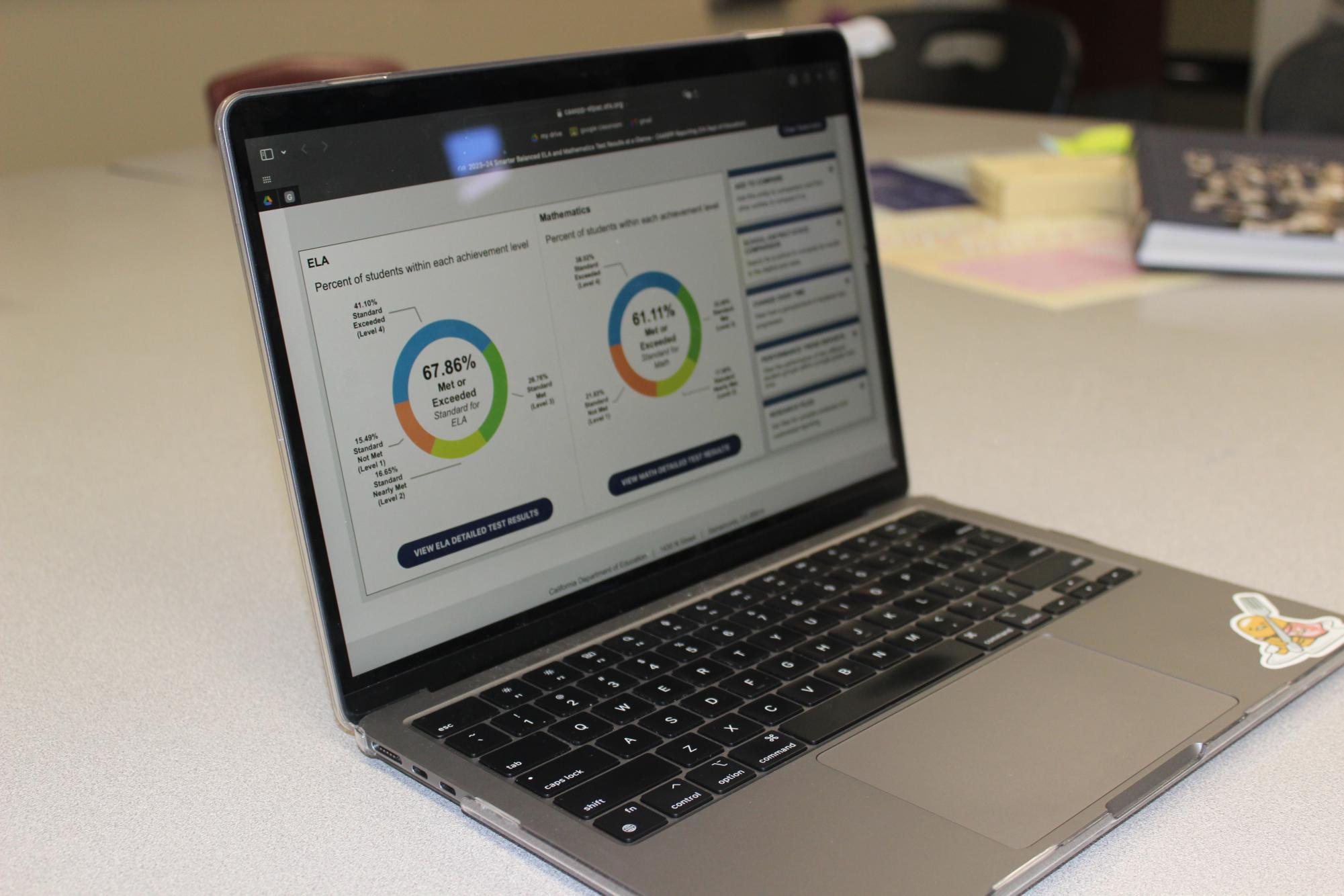Arcadia High School (AHS) has seen a decline in the rate of juniors that meet or exceed California English and math proficiency standards, upon the October release of state testing scores from the 2023-2024 school year. Like the rest of the eleventh graders in the state, Arcadia’s juniors took the California Assessment of Student Performance and Progress (CAASPP) last year, an annual statewide exam administered to grades three through eight and grade eleven. However, unlike the rising percentages of California students meeting or exceeding standards (demonstrating proficient or advanced grade-level knowledge and skills) in ELA, mathematics, and science, AUSD and AHS students saw a significant drop in performance from years prior and compared to other high performing high schools in the area. On average in California in 2024, the percentages of California students meeting or exceeding standards increased slightly from 2023, up 0.3% percent in ELA and 0.9% in math. On the other hand, AHS saw these rates drop 5.3% in English and 0.56% in math for the same class.

In the Smarter Balanced Summative Assessments for English Language Arts/Literacy, 41.10% of AHS juniors exceeded state standards, 26.76% met them, 16.65% nearly met them, and 15.49% did not meet them. A total of 67.86% met or exceeded the standard for ELA. AHS juniors performed best specifically in writing, with 42.77 % of students being rated above standard, and most poorly in listening, with only 23.43 % above standard. In the assessments for math, 38.02% exceeded state standards, 23.09% met them, 17.06% nearly met them, and 21.83% did not meet them. A total of 61.11% of AHS juniors met or exceeded the standard for math. AHS’ lowest scores in math were in the problem solving and modeling & data analysis category, with a mere 33.25 % scoring above standard. This data comes from 781 eleventh grade students (now twelfth grade) tested in English and 797 in math, from the 802 students that made up the class of 2025.
To put these numbers into perspective, La Canada Unified School District released an email to district families with data on the same score report in question (pictured here), comparing LCHS to the other high schools in the area that are generally regarded as “high performing.” Arcadia was included in the data table, despite scores (standards met or exceeded) well below the majority of others included. There are substantial quantitative differences between those districts and AUSD’s in recent standardized testing scores, which seems to highlight a disparity between the typical academic performances of AHS and AUSD students and these results.

“I think that there’s no question that academics, grades and test scores matter at Arcadia high school, but our focus and the focus of our students has really always been our AP pass rate, our AP classes,” said AHS Principal Dr. Angie Dillman. “And I know that students who are taking the SAT and ACT care deeply about those scores. And our average scores for our school are very high.”
It’s important to note that the CAASPP results include the scores of Arcadia’s English Language and Development (ELD) students on the English Language Proficiency Assessments for California. The Arcadia Language Census from the 2018 to 2019 school year showed that AUSD has roughly 1,115 English learners and roughly 4,090 fluent English proficient students (with a different first language than English), so this is likely a contributing factor to AUSD and AHS’ relatively lower proficiency percentages compared to other high ranking area schools. Besides language proficiency, other demographic aspects also come into play in analyzing our CAASPP scores.
“I think when it comes to this state test, I think there are a variety of factors why our scores are different from the other schools. We’re much larger; we have a much more diverse population. That means that students move here and move away more frequently… And in LA Canada and San Marino, there aren’t any apartments,” said Principal Dillman. “It’s a totally different city and has different needs. That being said, I think that our students are just as capable as those students.”
Recognizing that these results were not reflecting the highest capabilities of AHS students, Dr. Dillman and the AHS administration have had discussions on the results and have made some decisions on the direction to take in addressing this score drop. More data from the 2024-2025 school year and its test administration will likely be important to see before any significant changes to Arcadia High School and AUSD though.
According to Principal Dillman, one factor possibly bringing down our CAASPP results is the lingering effects of the COVID-19 pandemic. It may even be that the CAASPP test’s accuracy in reflecting true student capability was also affected; this test should have last been administered to the Class of 2025 in eighth grade, but was instead last taken in sixth grade, making measuring growth more difficult for AUSD and deemphasizing the importance of the test to students. Tests for 2020 were not given statewide due to the Covid-19 pandemic, whereas testing in 2021 was optional. The test-takers for this data set are from the class of 2025, who were in seventh grade at the beginning of the pandemic, midway through eighth grade upon AUSD’s optional return to school, and were (for the most part) required to start ninth grade in person.
Another possible factor is the specifics of AHS’ test administration. Several years ago, the student school site leadership team posed the question of when the test should be given to the student body, and students favored taking the CAASPP in January (the test was administered in January in 2024). The overwhelming majority did not want it to interfere with AP tests, resulting in the test being moved back earlier in subsequent years. This break from the norm would have meant that students had almost half a school year less of junior-mandated English classes, optional math courses, and classes with related critical thinking skills such as United States history.
Finally, according to administration, staff, and even students, the seemingly most prevalent factor acting on these results was apathy.
“We have to do the work of helping students understand this might not impact your grade, but it does impact the reputation of our school and the ranking of our school, and even though we’re considered a high performing high school for many legitimate reasons, this could be another contributing factor to those reasons,” said Principal Dillman.
“We believe that the numbers that we’re seeing may not be necessarily indicative of the actual state of our students, in that we understand that a very high population of people decide that they don’t care about these tests since they have no stakes in them whatsoever,” said AHS English teacher Christopher Schultz. “They’re not attached to grades; they’re not attached to college admissions and so on. So sometimes our students and those people who proctor the test see that students actually finish in five or 10 minutes, shut their computers down and say, ‘I’m done’ after they’ve clicked as many buttons as they could, as fast as they could. So we’re trying to find out how we might be able to make these tests have some level of importance, so we can more accurately judge where our students are.”
There appears to be a general consensus that adverse effects of pandemic learning contributed slightly, but overall, the lower than expected scores can be largely addressed with more emphasis on the test to students.
“They’re not apathetic with schoolwork, but I do see some skill level deficits over what I used to see,” continued Schultz. “There was a lack of gain during that pandemic period that still hasn’t been made up.”
“When I saw the results, I was disappointed because I thought last year’s class was highly talented. I thought that it was the first class that has come back from COVID. I don’t think these scores truly represent the students’ intellect. As a district and as a school, we want the school profile to be an actual representation of what we see in the classroom,” said fellow English teacher Nicole Zaidi. “I believe pushing back the time of the test, talking to the kids about the importance of the test and how it can impact them when they submit their [applications to] colleges could help bring up the test scores.”
“I wouldn’t be surprised with the recent CAASPP testing results,” said AHS math teacher Deborah Davidson. “ I want to emphasize that this isn’t the students’ fault; social media and apps are also a contributor to the problem.”
From the perspective of a participant in this round of testing, it was undeniable that a majority of the juniors taking the test finished both days of testing far ahead of the pace allowed by the state time requirements.

The disparity between AHS’ high performing reputation and CAASPP scores recently, however, doesn’t spell a death sentence for future tests. Principal Dillman remains optimistic, already brainstorming about ways to help students in their performance.
“And I think that that reflects the seriousness that our students put into their homework and their everyday work compared to the seriousness they put into this test. It’s different. So I think it’s on us to, like, help students put that same effort in, because if 30% put in more effort, and even half of them met standards, you know, our test resorts would be stellar,” said Dillman.
Even if AHS places a higher emphasis on the CAASPP, students and parents may still wonder if their personal results matter to them as an individual. The short answer is no, personal CAASPP results will not be available to colleges or affect GPA. However, they have repercussions on a student’s academic journey nevertheless. These results are a factor in decisions about the allocation of state education funding, as well as collecting data that reflects on AHS teachers and administrators. In fact, one student’s contribution to AHS’ collective score has great bearing on our academic reputation, so in a roundabout way, CAASPP scores are indeed factored into the college admissions process.
“We’re trying to put everyone in the situation where the test reflects their learning, because I think we owe it to all the students,” said Dillman.














